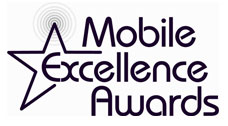First, don’t let the title fool you: “Abigail’s X-Rated Teen Diary” is really G-rated. But the “X-rated” got your attention, didn’t it? That’s exactly what creator Hayden Black intended. Abigail is a teen-aged girl who has ‘Bloomberger’s disease’, which makes her look like a 30-something bearded guy (kind of like Hayden Black). Her signature phrase – awkward turtles! – and her optimistic and cheery cluelessness has endeared her to a largely female 12 to 24 year old demographic.

Abigail
Launched in October 2007, the 1-minute videos have garnered well over 1.5 million hits a month. They’re also going mobile, via BuzzWire and MyWaves.
If the name Hayden Black rings a bell, it’s probably because of his earlier venture “Goodnight Burbank,” a spoof of evening news that launched in 2005 with a cast of TV/movie actors and starring Black as a supercilious newscaster with a cast of characters.
MobilizedTV spoke to Black about Abigail’s popularity, how studios fail at interactivity, and
How did you develop the idea of Abigail and her diary?
The last time I had spoken to a teenager was when I was a teenager. I wanted to see what they were like instead of how the media portrays them. A friend of mine has a teenage daughter and the three of us sat down and I started talking to her and asking her questions and we emailed. “Goodnight Burbank” also has a huge [teen] fan base on MySpace who I got a lot of feedback from. The idea was to get to what kids are thinking. The first thing I noticed was how cynical, jaded and sarcastic they were. And I had completely forgotten how cynical, jaded and sarcastic I was as a teenager. Although they’re portrayed as anything but on TV.
I think that’s why Abigail works, because of how cynical and jaded a lot of kids are. None of them has grown up in an era where they don’t know TV. They’re been marketed to from day one. When I used to work on promos for the TV networks, listening the way they talked about promoting to the kids was a joke. They talked down to them.
For example, Miley Cyrus announced she was embarrassed about the semi-topless pictures she had taken. I looked at the pictures and girls go out to nightclubs wearing less. Of course she’s not embarrassed. It’s all publicity and marketing. The people behind her, the industry machines, assume that by saying something is true, kids will believe them. Kids are far savvier than that. We are far savvier than that. I immediately recorded an episode – I improvised in one take to the camera – with Abigail screaming and crying that she was embarrassed for Miley. The adults watch it and say, that’s what the kids think. But the kids watch it and realize I’m making fun of the machine and the people behind that. They know it’s all an act.
I spent six months developing Abigail. A lot of shows on the Internet could be improved a thousand fold if some development went behind it and some writing.
Who’s watching Abigail?
The vast majority is female aged 12 to 24. We have both anecdotal evidence, seeing who writes in. And we did a survey on the website and it’s about 75 percent female.
Right now, on the Internet, you have two crowds watching: the post-college work crowd looking for a distraction during work. They’re looking for things that are quick and easy to get to. Then you have your high school crowd, and they’re looking not just for a distraction but to get involved. They’ll much more easily interact with your storyline, whether it’s emailing you directly, sending their own videos to you, checking in on other fans. I’ve watched people on Facebook who have submitted videos to Abigail and then become friends with other fans on the show. So that network spreads.
How have you grown the interactive elements of Abigail?
If you’re looking to do something interactive, you need to engage the fans. If you look at start-up production companies like mine, I get to invest time in making sure that the interactions fans have with Abigail are organic, fun and original. Someone wrote me back, with smiley faces, saying, “Yay, you’re not a robot.” And that’s because they’ve run into robots before on Internet shows. Obviously these kids can tell.
Studios have to overcome their inability to be personal. They have to move forward out of corporate-speak and these bland responses they may offer and truly engage these people with writing.
But if you’re the head of a studio, you don’t have the time to sit there and write. Even the writer doesn’t have enough time to write. You hire college interns to respond for you in character, but then you’re giving away the keys to the kingdom. If they say something offensive or wrong, you’ve hurt your brand and then it’s not just that particular show that suffers but all the shows the studio produces. The studios do have a lot more to worry about. Their responses and interactions will be a lot blander and more corporate because it’s all that structure can allow for.
Do you have plans beyond the Internet and mobile platforms?
We’ve done a deal with HeavyBag Media and RealTime Matrix. They’re building a widget for Abigail that will be cross-platform for fans on Facebook, MySpace and Bebo. It’ll have all the videos plus exclusive greetings you can send to your friends. What makes it unique is you’ll be able to talk in real-time to someone using this on MySpace or Facebook. It’s like a cyber chat room. You’ll be able to text-based chat to people on other social networks. HeavyBag is doing the social networking and advertising and RealTime Matrix is building the technology and infrastructure and will also help with advertising. For fans, the more they interact, the more their status improves. They go from BFF to BFF@evs (best friends for ever and ever)
We’ll also try to give away prizes. An author of a book has given us three prizes to give away. Two authors of books big with females are looking for press and publicity, so we’ll give those books away.
It seems that Abigail would be easy to monetize with merchandising.
As far as merchandising, we’ve talked about books with Abigail’s little pieces of prose in the margins. We’re talking about an Abigail bubble-head doll. We definitely see the potential for a TV series, which was again one of the things sketched out in the beginning. It wouldn’t be the same but the same things would be at the base.
The idea is that anything that I develop has legs to be able to go to TV and features and various merchandising. Otherwise, what’s the point? It’s great to be able to come up with a quick, cheap easy idea to produce for the Internet, but in the long run that doesn’t get you much. I think it’s about finding unique original stories and concepts and developing them.
What makes this premise different from “Ugly Betty”?
“Ugly Betty” is an adult. This hits the universal theme of issues with self-esteem when it is at its rawest. Certainly with females, the body is changing, they’re being looked upon like an outsider, they feel like outsiders, and Abigail is there to make it all right with naivete, silliness and a joke and overall goofiness. I think this is what fans are responding to. We’ve had you’re putting a voice to the unloved, the unwanted. Abigail through accident and design has become a character who is influencing peoples’ lives.
What are some of the anecdotes you’re hearing from fans?
One girl wrote to say her whole family is gathered around the laptop. So, yes, the family watches together. We occasionally flirt with a PG joke, but very rarely – and then it’s only a flirt. We don’t go there. There’s no reason to. I police it myself to make sure we don’t go too far.
We heard from two teens who, when their teacher misspoke, said “awkward turtles!,” which is Abigail’s way of being understanding when someone does something embarrassing. He didn’t get it and put them into detention. Later, he looked up Abigail, figured it out and apologized to the two girls.
Abigail is responsible for a fan getting engaged. We do an occasional Dear Abby segment. One was from someone who wanted her boyfriend to propose to her before Christmas. Abigail responded with a silly reply, the girl showed it to her boyfriend who laughed and proposed 24 hours later.
Any surprising fans?
We had an email from a unit of Marines in Iraq who said, we enjoy your show, would you give us a shout out. I asked for their names, and did a whole episode, using the names of their unit. From Abigail’s skewed perspective of course.
How does Abigail work on the mobile platform?
Abigail is perfect for that. Everybody says the perfect length for mobile is x or y. No, the perfect length is until it gets boring. Abigail works great in minute-long chunks because it’s a monologue. If we were taking it not just as a monologue but interacting with schoolmates and going to the mall, you’d have longer episodes. But a monologue- at 30-seconds you’re done. Now we’re branching out and having “Abigail’s X-rated Interviews” where she does interview for her high school newspaper with celebrities. The first was with Carolyn Lawrence, who is the voice of Sandy Cheeks in the “SpongeBob SquarePants” as well as Orel Pupppington in “Moral Orel.” It’s Ali G-esque because it’s from Abigail’s perspective, but the guests know what’s going on. Those will be edited down to about four-minutes. Abigail just went up on Glam.com. We’re also going to do an Abigail special in England, where TV celebrities will appear in 1.5-minute episode. To them it’s a cameo, for me, but for me, it’s a starring role.














